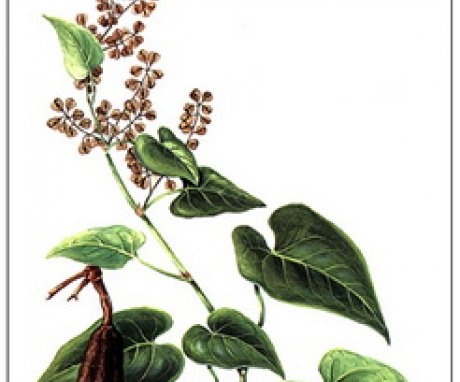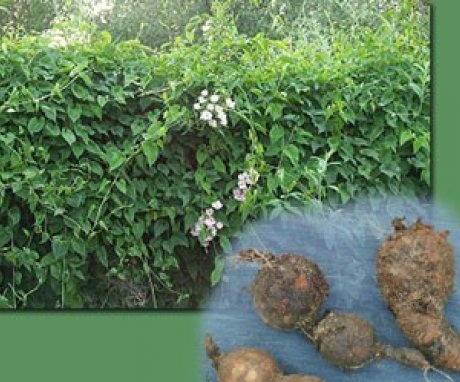Highlander multiflorous - an oriental guest in your garden
A huge number of miraculous properties are attributed to the root of the multiflower mountaineer. The flower itself comes from China and rightfully occupies an important place in traditional medicine. The multiflorous mountaineer can be easily grown in a personal plot.
Content:
Description of the multiflorous mountaineer
Latin name Polygonym multiflorum. It belongs to the angiosperms department, to the dicotyledonous class and the buckwheat family.
Plant appearance:
- leaves are alternate, lanceolate, entire, green;
- flowers are bisexual, white, collected in racemose inflorescences;
- has a pivotal root system;
- the fruit is a triangular nut.
The flowering period is late August - September and October. Highlander bears fruit in October - November. This species is propagated by seeds, rhizome processes and division of the bush. Distribution - Central Asia (Korea and China) on foothill rocky landscapes, where it grows all year round.
A single plant can be up to several hundred years old. In South Asian countries, it is widely used in traditional medicine. Its powerful rhizomes, rich in nutrients, are mainly used.
In appearance, the multiflorous mountaineer is climbing vine.
The plant is a wild perennial, prefers rocky cool places. The garden is suitable for rock gardens, flower beds and decorating the facades of houses and fences. It has a powerful branching root system and grows rapidly. Vines can be up to 15 meters long. In one season it grows 3-5 meters.
Since it is the dominant plant, it is combined with good growing cereals... Cultivating this miracle root, you can combine business with pleasure.
Plant agrotechnology
You can buy the multiflorous mountaineer at the pharmacy. But, since it belongs to unpretentious plants, it is easy to grow it yourself in the country and even at home. It should be planted in shaded, well-ventilated places inaccessible to direct sunlight.
Before planting, seeds are stratified for 1-2 months in order to increase germination, since they are dormant.
There are several ways to stratify:
- Soak the seeds in warm water for 24 hours, then put them in the refrigerator on the lower shelf or in the lower drawer.
- Place the seeds in a well-dampened napkin or cloth, wrap them in a bag and send them to the refrigerator.
- Arrange the seeds in a small container filled with earth or a special hydrogel, moisten and refrigerate.
To prepare seeds for planting, you can use not only the refrigerator, but also the basement of the house. The main thing is that the temperature is in the range from 0 to +5 degrees. During the stratification process, it is necessary to ensure that the seeds are in a humid environment. If such a long preparation is not possible, then it is permissible to plant seed material before winter.
In order for the seeds of a mountaineer to germinate, it is necessary, after processing (mentioned above), to spread them out in the light at a temperature of 18-25 degrees. Everything is now ready for outdoor planting.
Disembarkation takes place in May. For planting, the soil should be well humified, loosened and sufficiently moist. The multiflorous mountaineer is not capricious to the acidity of the soil and does not require additional fertilizers.During the growing season, you can make complex fertilizers.
Despite the fact that the rhizome will tolerate the transplant well, along with a lump of soil, it is not advisable to do this for the first 2-3 years.
Flowering begins in the 2-3 year of the plant's life. For the successful agricultural technology of the mountaineer, you should monitor the moderation of watering and avoid waterlogging of the soil. Watering the plant is necessary when the top layer dries.
When planting a knotweed in a personal plot, it should be remembered that the root grows very quickly. In this regard, the roots must be limited by digging 30-50 cm deep curbs around the perimeter.
The multiflorous mountaineer is also cultivated as a houseplant. For good growth and development, it needs to provide good drainage and spraying. Since this is still a street plant for the winter, it goes into a dormant period. The pot with it must be rearranged to a cool place. Since the flower is closer to the wild, it will not be difficult to grow it.
Beneficial features
The popularity of the multiflorous mountaineer came to us from China. There he is called "Ha Thu O" or "Fo Ti" and is credited with truly miraculous properties. It is able to slow down the aging process and is recommended for many diseases.
Highlander multiflorous is good for hair. It is believed that its use can restore strength and color even to gray hair.
In addition, in folk medicine, it is used in the following cases:
- cardiovascular diseases
- atherosclerosis
- insomnia
- cleansing the kidneys
- increased immunity
- nervous disorders.
This is not a complete list of the areas of application of the plant. Its regular intake allows you to improve the functions of the whole body and bestows longevity. The plant contains antioxidants that help fight obesity, prevent fatty liver and even help fight cancer. Alkaloids have a calming effect on the nervous system and help in the fight against infertility. Anthrocyanides have anti-inflammatory effects.
It is believed that the older the root (from 50 years old), the greater the spectrum of its action.
The harvest of rhizomes harvested on your site can be used in the form infusions and decoctions... One of the recipes is very simple. 25 grams of chopped multiflorous mountaineer is placed in a bottle and poured with vodka. For two weeks, the mixture is insisted in a dark place, shaking occasionally. Take 30 drops daily, two to three times, for at least a month.
The multiflorous mountaineer has truly miraculous properties. No wonder there are many eastern legends about him. Everyone can touch this miracle and feel the effect.














In the village they somehow raised a mountaineer, but then they got rid of it for 2 years. It grows very big and strong.